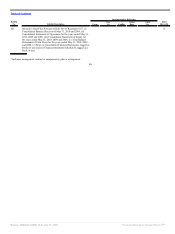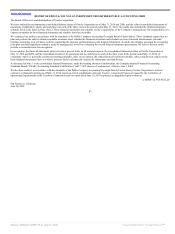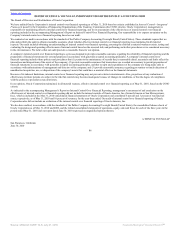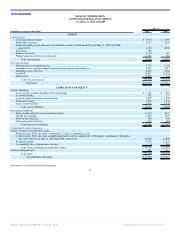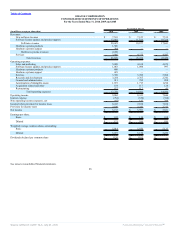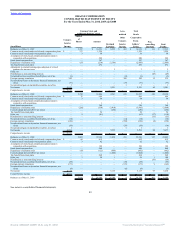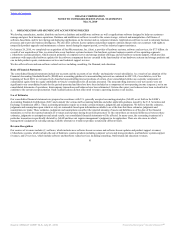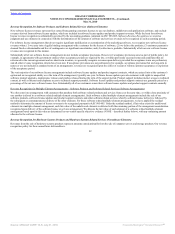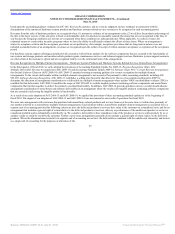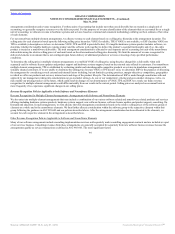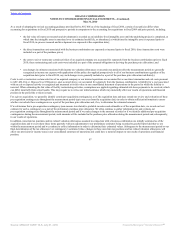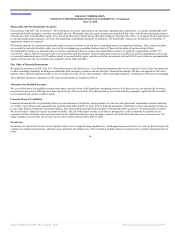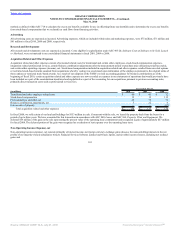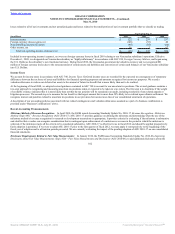Oracle 2009 Annual Report Download - page 97
Download and view the complete annual report
Please find page 97 of the 2009 Oracle annual report below. You can navigate through the pages in the report by either clicking on the pages listed below, or by using the keyword search tool below to find specific information within the annual report.
Table of Contents
ORACLE CORPORATION
NOTES TO CONSOLIDATED FINANCIAL STATEMENTS—(Continued)
May 31, 2010
based upon the accounting guidance contained in ASC 605, Revenue Recognition, and we exercise judgment and use estimates in connection with the
determination of the amount of hardware systems products and hardware systems related services revenues to be recognized in each accounting period.
Revenues from the sales of hardware products are recognized when: (1) persuasive evidence of an arrangement exists; (2) we deliver the products and passage of
the title to the buyer occurs; (3) the sale price is fixed or determinable; and (4) collection is reasonably assured. Revenues that are not recognized at the time of
sale because the foregoing conditions are not met are recognized when those conditions are subsequently met. When applicable, we reduce revenues for
estimated returns or certain other incentive programs where we have the ability to sufficiently estimate the effects of these items. Where an arrangement is
subject to acceptance criteria and the acceptance provisions are not perfunctory (for example, acceptance provisions that are long-term in nature or are not
included as standard terms of an arrangement), revenues are recognized upon the earlier of receipt of written customer acceptance or expiration of the acceptance
period.
Our hardware systems support offerings generally provide customers with software updates for the software components that are essential to the functionality of
our systems and storage products and can also include product repairs, maintenance services, and technical support services. Hardware systems support contracts
are entered into at the customer’s option and are recognized ratably over the contractual term of the arrangements.
Revenue Recognition for Multiple-Element Arrangements – Hardware Systems Products and Hardware Systems Related Services (Nonsoftware Arrangements)
In the third quarter of fiscal 2010, we early adopted the provisions of Accounting Standards Update No. 2009-13, Revenue Recognition (Topic 605)
Multiple-Deliverable Revenue Arrangements (ASU 2009-13) and Accounting Standards Update 2009-14, Software (Topic 985)—Certain Revenue Arrangements
that Include Software Elements (ASU 2009-14). ASU 2009-13 amended existing accounting guidance for revenue recognition for multiple-element
arrangements. To the extent a deliverable within a multiple-element arrangement is not accounted for pursuant to other accounting standards, including ASC
985-605, Software-Revenue Recognition, ASU 2009-13 establishes a selling price hierarchy that allows for the use of an estimated selling price (ESP) to
determine the allocation of arrangement consideration to a deliverable in a multiple element arrangement where neither VSOE nor third-party evidence (TPE) is
available for that deliverable. ASU 2009-14 modifies the scope of ASC 985-605 to exclude tangible products containing software components and nonsoftware
components that function together to deliver the product’s essential functionality. In addition, ASU 2009-14 provides guidance on how a vendor should allocate
arrangement consideration to nonsoftware and software deliverables in an arrangement where the vendor sells tangible products containing software components
that are essential in delivering the tangible product’s functionality.
As a result of our early adoption of ASU 2009-13 and ASU 2009-14, we applied the provisions of these accounting standards updates as of the beginning of
fiscal 2010. The impact of our adoption of ASU 2009-13 and ASU 2009-14 was not material to our results of operations for fiscal 2010.
We enter into arrangements with customers that purchase both nonsoftware related products and services from us at the same time, or within close proximity of
one another (referred to as nonsoftware multiple-element arrangements). Each element within a nonsoftware multiple-element arrangement is accounted for as a
separate unit of accounting provided the following criteria are met: the delivered products or services have value to the customer on a standalone basis; and for an
arrangement that includes a general right of return relative to the delivered products or services, delivery or performance of the undelivered product or service is
considered probable and is substantially controlled by us. We consider a deliverable to have standalone value if the product or service is sold separately by us or
another vendor or could be resold by the customer. Further, our revenue arrangements generally do not include a general right of return relative to the delivered
products. Where the aforementioned criteria for a separate unit of accounting are not met, the deliverable is combined with the undelivered element(s) and treated
as a single unit of accounting for the purposes of allocation of the
93
Source: ORACLE CORP, 10-K, July 01, 2010 Powered by Morningstar® Document Research℠



